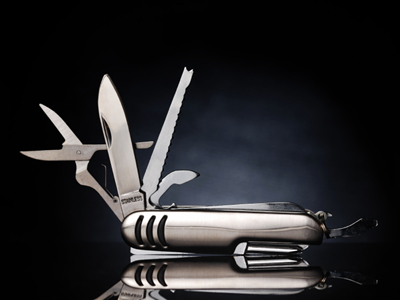This quiz looks specifically at metallic bonding. It's difficult to imagine life without metals, we use them in practically every aspect of our lives. Virtually everything involves metals in some way but what makes them so useful? In a word - bonding. The arrangement of their atoms gives metals certain characteristics which are very useful to us. High melting and boiling points, reflection of light, conduction of heat and electricity - these are all properties that we take advantage of in some way.
In metals, the atoms are packed together really closely and this causes some of the outer electrons to break free and float around within the structure of the metal. We say that the electrons are delocalised. Because they have lost electrons, metal atoms are in fact metal ions, but you don't notice this because of the delocalised electrons. Since there are as many delocalised electrons as metal ions, the overall charge is still neutral.
Normally, the motion of the electrons is random and they can move anywhere in the metal. At high school level, the structure is often described as being 'metal ions in a sea of electrons'. The attraction between the 'sea' of electrons and the metal ions is very strong and we call it metallic bonding.
The positive metal ions are free to slide over one another and this makes metals malleable and ductile. The sea of electrons is spread throughout the metal, and so when it is pulled into wires, hammered to make it thinner or bent into a new shape, the overall composition and structure of the metal is not changed. The metal ions will have been rearranged but the sea of electrons adjusts to the new arrangement, keeping the metal intact. Some metals can be beaten into very thin sheets of foil without breaking. A good example of this is beating gold to make gold leaf. This can only be done because of metallic bonding.
The sea of electrons present in metallic bonding makes metals good conductors of heat. Heat is simply an area where particles have a greater kinetic energy (energy of movement) than their neighbors. So when you heat part of a piece of metal, the ions and electrons have more kinetic energy. The electrons will therefore move faster and further than they did when they were cooler, carrying the extra kinetic energy through the metal. At the same time, because the metal ions are so closely packed, they vibrate more and as they hit neighboring ions, they too transfer the heat through the metal.
Metallic bonding also helps to explain why metals are able to conduct electricity. If you connect a piece of metal to an electrical potential difference (a voltage) e.g. an electrical cell, the electrons will move from the negative pole to the positive pole. So now the movement of electrons is less random and they all flow in the same direction through the metal which we recognize as an electrical current. Electrons are also affected by magnetic fields so when a metal is moved in a magnetic field, the delocalised electrons all tend to move in the same direction - this is how a generator or dynamo works.
Have a go at this final quiz on bonding and see how well you understand the arrangement of atoms in metallic bonding.








